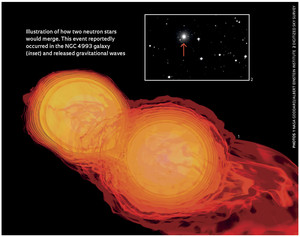 On August 18, 2017, two astronomers from universities in the United States posted messages on Twitter spreading the rumor that the Laser Interferometer Gravitational-Wave Observatory (LIGO) had allegedly made a new major discovery. Since September 2015, LIGO has three times detected gravitational waves–space-time oscillations that travel at the speed of light and lengthen and compress objects they meet along the way that emerge from colliding black holes. Currently the observatory has two sensors in the United States which reportedly detected a new type of gravitational wave that comes from the merger of two neutron stars that are extremely dense celestial bodies, created by the implosion of the nucleus of giant stars. The unusual event was apparently caught at a point in the NGC 4993 galaxy, in the southern constellation Hydra, 130 million light years away from Earth. The rumor spread and was finally put to rest on the sites of scientific communication journals such as New Scientist of Great Britain and Nature. The media confirmed that there had been requests from LIGO and Virgo, the European gravitational-wave observatory in Italy, to have telescopes in space and on Earth train their instruments on that galaxy to attempt to produce an image of the event. On August 25, 2017, the US-Europe collaboration issued a communiqué stating that “some promising gravitational-wave [events] were identified in both LIGO and Virgo during our preliminary analyses, and we have shared what we currently know with partners in the field of gravitational astronomy.”
On August 18, 2017, two astronomers from universities in the United States posted messages on Twitter spreading the rumor that the Laser Interferometer Gravitational-Wave Observatory (LIGO) had allegedly made a new major discovery. Since September 2015, LIGO has three times detected gravitational waves–space-time oscillations that travel at the speed of light and lengthen and compress objects they meet along the way that emerge from colliding black holes. Currently the observatory has two sensors in the United States which reportedly detected a new type of gravitational wave that comes from the merger of two neutron stars that are extremely dense celestial bodies, created by the implosion of the nucleus of giant stars. The unusual event was apparently caught at a point in the NGC 4993 galaxy, in the southern constellation Hydra, 130 million light years away from Earth. The rumor spread and was finally put to rest on the sites of scientific communication journals such as New Scientist of Great Britain and Nature. The media confirmed that there had been requests from LIGO and Virgo, the European gravitational-wave observatory in Italy, to have telescopes in space and on Earth train their instruments on that galaxy to attempt to produce an image of the event. On August 25, 2017, the US-Europe collaboration issued a communiqué stating that “some promising gravitational-wave [events] were identified in both LIGO and Virgo during our preliminary analyses, and we have shared what we currently know with partners in the field of gravitational astronomy.”